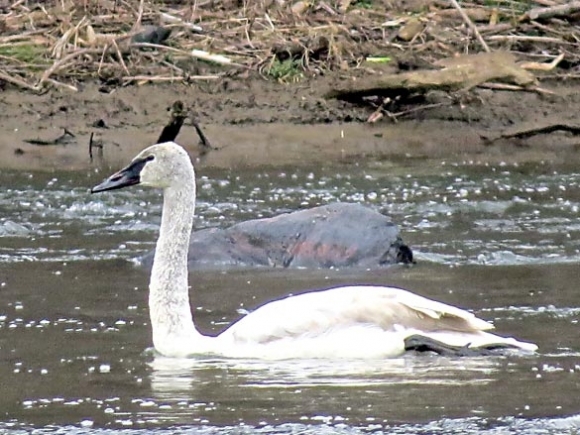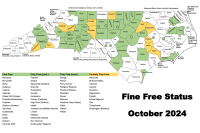What me chase?

Regular readers of “The Naturalist’s Corner” may remember that I’ve decided to keep a 2017 year-list of birds. I noted, when I wrote about the list that I was not much of a “lister” nor “chaser.” My list would be made up of birds encountered in my backyard and during my Forest Service point counts and maybe a day of birding during our summer vacation to Isle of Palms.
Then, last Sunday (Feb. 26) Dwayne Martin posted some pictures of a trumpeter swan that had been hanging around Ledges Riverside Park on the French Broad River just north of Asheville.
OK, so I’m really not a chaser — but it’s only Asheville, right? And it is a trumpeter swan — the largest native waterfowl in North America and nearly extirpated by the turn of the 20th century. About the only place to regularly find one in North Carolina is at Mattamuskeet National Wildlife Refuge. It sure would be nice to have a big ole trumpeter swan on my year-list, huh?
Monday morning (Feb. 27) after school drop off, I somehow found myself headed east on I-40, then north to Woodfin and miraculously, a few minutes later, I was at the entrance to Ledges Riverside Park. So, OK, maybe I chase a little.
I scanned the river at the park and saw no large white bird — a few Canada geese but no swan. I hiked upriver about half a mile and still no big bird. I turned and headed back to the park thinking how foolish chasing could be. When I reached the park again I glassed downriver with my binoculars. Oh, wait, what’s that white spot? I got to a better vantage point and raised my binoculars again — that was definitely a large white bird, but it appeared to be lying in the water — no head or neck visible. Scenarios began to race through my head: “Had someone shot the swan and left it in the river? Maybe it was sick or injured, and that was why it had wound up in the French Broad in the first place?”
And then as I was ruminating on different explanations, a long white neck and heavy black beak snaked out of the water like Nessie breaching on the Loch Ness. The swan had been grazing on algae or some other aquatic vegetation, as it would during the time I watched it that morning, with head submerged for 20 to 30 seconds at a time.
Related Items
The trumpeter swan, so named because of its loud trumpeting call, dwarfed the Canada geese in the river near it. Trumpeter swans can reach nearly 6 feet in length and weigh between 25 and 30 pounds, with a wingspan of more than 7 feet. As I mentioned earlier, they were nearly extirpated by the early 20th century. Market hunting for meat and feather collecting for the millinery trade almost wiped this avian giant from the planet. It was thought that by the early 1930s there were fewer than 100 wild trumpeters left in North America.
But then a breeding colony numbering in the thousands was discovered in Alaska along the Copper River. Through the painstaking work of various wildlife agencies and the Trumpeter Swan Society, the population today numbers more than 45,000. But they still face threats such as loss of habitat and lead poisoning.
The bird at Ledges was an immature. Trumpeters have a strong pair bond; maybe this bird will find a mate and both will return to Asheville next year. If I’m gonna chase, might as well chase dreams too, huh?
Don Hendershot is a writer and naturalist. He can be reached at This email address is being protected from spambots. You need JavaScript enabled to view it..









